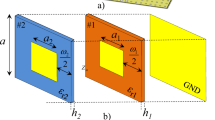Abstract
The accurate prediction of radar cross-section (RCS) of various structures is crucial for controlling its visibility and hence plays a vital role in the development of stealth technologies. Several approaches like body geometry decomposition, low frequency techniques, high frequency techniques, and hybrid methods can be employed for RCS estimation based on the complexity of geometry and electrical size of the structure. Scattering entities especially electrically large ones give rise to a wide variety of electromagnetic phenomena like refraction, reflection, traveling waves, leaky waves, diffraction effects, etc. Although low frequency techniques provide accurate predictions for complex geometries, the computational complexity increases with electrical size of the structure. On the other hand, high frequency approaches, although computationally efficient for electrically large problems, give incorrect results when the problem under consideration has intricate geometrical features. Therefore, hybrid approaches incorporating both of them have been introduced to solve electromagnetic problems where neither class of formulations is sufficient by itself. This chapter presents an overview of these methods and certain case studies are also included for better clarity. Further, the popular approaches employed for reduction of RCS are also included with special emphasis on radar absorbing materials (RAM)/radar absorbing structure (RAS) and antenna array.
Similar content being viewed by others
References
Bondeson A, Rylander T (2013) Computational electromagnetics. Springer, New York. ISBN 978-0-387-26160-7, 288 p
Bouche DP, Molinet FA, Mittra R (1993) Asymptotic and hybrid techniques for electromagnetic scattering. Proc IEEE 81(12):1658–1684
Cadirci S (2009) RF stealth (or low observable) and counter-RF stealth technologies: implications of counter-RF stealth solutions for Turkish Air Force. Master’s thesis, Naval Postgraduate School, California, 161 p
Choi WH, Shin JH, Song TH, Kim JB, Cho CM, Lee WJ, Kim CG (2014) Design of circuit-analog (CA) absorber and application to the leading edge of a wing shaped structure. IEEE Trans Electromagn Compat 56(3):599–607
Genovesi S, Costa F, Monorchio A (2012) Low-profile array with reduced radar cross section by using hybrid frequency selective surfaces. IEEE Trans Antennas Propag 60(5):2327–2335
Harrington RF (2001) Time harmonic electromagnetic fields. Wiley-IEEE Press. ISBN: 978-0-471-20806-8, 496 p
Iriarte JC, Pereda AT, Falcón JLMD, Ederra I, Gonzalo R, Maagt PD (2013) Broadband radar cross-section reduction using AMC technology. IEEE Trans Antennas Propag 61(12):6136–6143
Joy V, Rajeshwari GL, Singh H, Nair RU (2020) Fundamentals of RCS prediction methodology using parallelized numerical electromagnetics code (NEC) and finite element pre-processor. In: Springer briefs in electrical and computer engineering-computational electromagnetics. ISBN:978-981-15-7163-3, 116 p
Kantikar R, Joy V, Singh H, Nair RU (2020) Resistive FSS based radar absorbing structure for broadband applications. In: International conference on electronics, computing and communication technologies (IEEE-CONECCT 2020), Bangalore, India, 1–4, July 2–4, 2020
Knott EF (2006) Radar cross section measurements. Scitech Publishing, Raleigh, NC. ISBN: 978-1-891121-55-5, 546 p
Knott EF, Schaeffer JF, Tuley MT (2004) Radar cross section, 2nd edn. Scitech Publishing, Raleigh, NC. ISBN-13:978-1891121258, 626 p
Mitschang LNM, Wang DS (1989) Hybrid methods for analysis of complex scatterers. Proc IEEE 77(5):770–779
Munk BA (2000) Frequency selective surfaces – theory and design. Wiley, New York. ISBN:0-47 1-37047-9, 410 p
Paquay M, Iriarte JC, Ederra I, Gonzalo R, Maagt PD (2007) Thin AMC structure for radar cross-section reduction. IEEE Trans Antennas Propag 55(12):3630–3638
Ramkumar MA, Sudhendra C, Rao K (2016) A novel low RCS microstrip antenna array using thin and wideband radar absorbing structure based on embedded passives resistors. Prog Electromagn Res C 68:153–161
Saville P (2005) Review of radar absorbing materials. DRDC Atlantic, Dartmouth. Technical memorandum, TM-2005-003, 62 p
Shater A, Zarifi D (2017) Radar cross section of microstrip antenna using dual-band metamaterial absorber. ACES J 32(2):135–140
Singh H, Jha RM (2015) Active radar cross section reduction: theory and applications. Cambridge University Press, Cambridge, UK. ISBN: 978-1-107-09261-7, 325 p
Singh H, Singh A (2021) Low radar cross section HIS-based phased array: radiation and scattering analysis. CRC Press, Taylor & Francis, Boca Raton. ISBN:978-0367513900, 134 p
Singh A, Sasidharan DK, Singh H (2020) Analytical estimation of radiation mode radar cross section (RCS) of phased arrays. IEEE Trans Veh Technol 69(6):6415–6421
Teixeira FL, Chew WC (2000) Finite-difference computation of transient electromagnetic waves for cylindrical geometries in complex media. IEEE Trans Geosci Remote Sens 38(4):1530–1543
Woo AC, Wang HTG, Schuh MJ, Sanders ML (1993) Benchmark radar targets for the validation of computational electromagnetics programs. IEEE Antennas Propag Mag 35(1):84–89
Zhang HB, Zhou PH, Deng LW, **e JL, Liang DF, Deng LJ (2012) Frequency dispersive resistance of high impedance surface absorber with trapezoid-coupling pattern. J Appl Phys 112(1):1–6
Author information
Authors and Affiliations
Corresponding author
Editor information
Editors and Affiliations
Section Editor information
Rights and permissions
Copyright information
© 2023 Springer Nature Singapore Pte Ltd.
About this entry
Cite this entry
Joy, V., Singh, H. (2023). Radar Cross-Section (RCS) Estimation and Reduction. In: Aswal, D.K., Yadav, S., Takatsuji, T., Rachakonda, P., Kumar, H. (eds) Handbook of Metrology and Applications. Springer, Singapore. https://doi.org/10.1007/978-981-19-1550-5_83-1
Download citation
DOI: https://doi.org/10.1007/978-981-19-1550-5_83-1
Received:
Accepted:
Published:
Publisher Name: Springer, Singapore
Print ISBN: 978-981-19-1550-5
Online ISBN: 978-981-19-1550-5
eBook Packages: Springer Reference EngineeringReference Module Computer Science and Engineering




